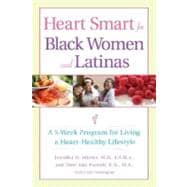
| Acknowledgments | p. ix |
| Foreword | p. xiii |
| Introduction | p. 1 |
| The Double Whammy: The High Risk of Heart Disease for Women in General and Black Women and Latinas in Particular | |
| Heart Disease: Women's Heart Disease Is Different from Men's | p. 9 |
| Assessing Your Risk | p. 15 |
| Don't Be a Statistic: It's Never Too Late to Get on the Road to Heart Health | p. 35 |
| Listen to Your Body | p. 43 |
| Three Small Steps to Heart-Healthy Living in 5 Weeks | |
| Week One: Get Ready by "Setting the Table" for the Rest of Your Life! | p. 53 |
| Week Two: Step 1: Get Moving! | p. 73 |
| Week Three: Step 2: Simple Steps to Healthier Eating | p. 87 |
| Week Four: Step 3: Stress Less and Enjoy | p. 111 |
| Week Five: FEAST: Putting It All Together for the Rest of Your Life! | p. 143 |
| Preventing Heart Disease for a Lifetime | |
| The Power of Partnering with Your Doctor | p. 155 |
| Appendices | |
| Resources for Heart-Smart Recipes | p. 169 |
| Helpful Health-Care Facts | p. 173 |
| Common Heart Medications, Treatment, and Tests | p. 181 |
| Questions and Answers About Heart Disease | p. 187 |
| Women's Heart Centers | p. 195 |
| Glossary | p. 220 |
| Suggested Reading | p. 227 |
| Index | p. 231 |
| Table of Contents provided by Ingram. All Rights Reserved. |
The New copy of this book will include any supplemental materials advertised. Please check the title of the book to determine if it should include any access cards, study guides, lab manuals, CDs, etc.
The Used, Rental and eBook copies of this book are not guaranteed to include any supplemental materials. Typically, only the book itself is included. This is true even if the title states it includes any access cards, study guides, lab manuals, CDs, etc.